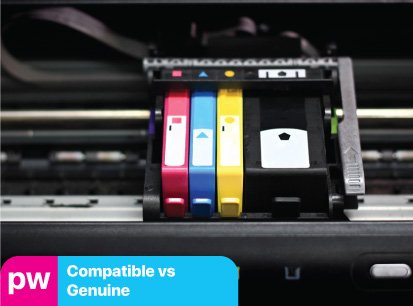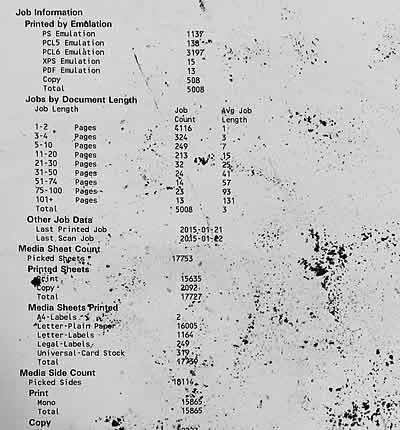Compatible vs Genuine Toner Cartridges

Tips to select compatible or genuine toner
Many business owners are now turning to “Compatible” or “Remanufactured” Toner Cartridges in an effort to save money. The modern compatible toners are guaranteed to be equal or to exceed the quality of the Genuine OEM Toners. There are so many companies online nowadays offering very cheap toner cartridges (all made in China). Be WARNED many are poor quality and some companies are still using the old "Drill and Fill" method which basically means a small hole is drilled in the side of the toner cartridge and then the toner is refilled (generally with a poor quality toner) and then sealed, boxed and resold.
If a toner appears to be too cheap then generally it is safe to assume that it is a low grade Chinese product which may work fine however generally they can cause all kinds of problems. This is one of the reasons compatible and remanufactured products have (In the past) been frowned upon by many!
Compatible Toners what exactly are they?
Most ink cartridge and toner products these days labelled "Compatible" are really whats known as "Remanufactured". The term Compatible is used simply to destinguish the product from a Genuine OEM product. A remanufactured Toner is simply a Genuine Toner which has been fully reconditioned. Now the degree of reconditioning which takes place is the most crucial aspect determining the quality of the final product. It's similar to having a Motor overhauled. Some companies will replace only rings and bearings while a more reputable company will rebore, replace pistons,rings,oil pump etc... So hopefully now you will start to understand why it is important as to who you purchase your "Compatible Toner Cartridges" from.
In the beginning of refill cartridges there were not many options. Toner and internal replacement parts were not readily available, so the quality was not as high as one would like. In recent years all that has changed. One of the most important components that should be replaced in a toner is the drum and the drum blade. These were designed to only last the life of the toner powder being used from the cartridge. If you were to reuse the original drum it would cause many print defects such as light print, marks and several other image defects. The drum blade would also create streaking and line type image defects. Think of the drum blade as a windshield wiper. When it wears out certain areas are not being cleaned and it makes it hard to see through the window! In the same way certain areas are not being wiped off and you then have lines on the printed pages.
We now have access to not only drums and blades but many other components that wear out and need to be replaced inside the toner cartridge. When selecting a company that refills or sells compatible toner cartridges, I would make sure that they do in fact replace the drum and drum blade, or it will not last and you will have wasted your time and money on something that was supposed to save you money in the first place.
Why Purchase Compatible Toner Cartridges?
Let me be very clear here. Unless you are buying a compatible Toner from a reputable reseller and the toner has been made in an ISO 9001 facility by a well known "Professional" company and you recieve a proper Guarantee then and only then would I advise you to use a compatible toner. Compatible Toners represent big cost savings and if they have been remanufactured by a reputable company then they will ALWAYS equal and in many cases exceed the yield of the Genuine product.
Other factors to consider are:
1. Cost - generally a compatible toner will sell for 50 - 150% Cheaper than the Genuine OEM Toner.
2. Yield - quite often a generic or remanufactured toner cartridge will contain more toner powder than the equivelant OEM brand name toner. This means the toner will print a lot more pages than the brand name equivelant.
3. Environmental - Why throw a used toner straight to Landfill when it can be fully reconditioned and re-used again? The average toner can be re-used up to 4 times which in turn can save up to 35 pounds of raw materials. This in turn reduces the amount of landfill needed to dump the old toner shells which would take hundreds of years to decompose.
Will Generic Toners damage my printer?
This is the question the consumer always wants to know and rightly so. In 10 years of selling non genuine toners I am yet to have a customer acuse me of damaging their printer. I am not saying that it cant happen because it can happen if a cheap, low grade generic toner is used.
Cheap, low grade generic toners have a common habit of leaking toner onto the drum and pinch rollers. This is one of the main reasons that remanufactured toners have such a bad reputation. I have experienced this myself and it is very annoying when a print comes out with a greyish background or a vertical line on every page.
Once the toner has leaked out into the printer then it can be a a nightmare to clean it all out and to get the drum nice and clean. If you simply re-install the offending toner then it will very quickly do the same thing again.
Examples of poor quality Generic Toners
Worn Wiper or Cleaning Blade
The image to the left is a typical print example from a poorly remanufactured generic toner. The Drum wiper or cleaning blade has not been replaced and the resulting printout is unnaceptable.
The only way to remedy this is to replace the whole toner with a new one or if the printer uses a seperate drum unit then clean it thouroughly and then replace the toner.
This is perhaps the most common of all issues that occur with a generic or remanufactured toner. Quality generic toners will always have a new wiper blade fitted.
Leaking Toner Powder
Another very common problem with low quality generic toners is leaking toner powder. This is a huge issue and can cause major problems with your printer if not fixed.
Once the toner leaks onto the drum unit and then onto pinch rollers etc then your printer will need some major repairs.
Often leaking toner shows up as in the image to the left or else in vertical lines on one side or even all over the page.
Cleaning can be done with compressed air once the toner has been removed. Often the drum will need a thorough cleaning to make sure the toner is completely removed.
Damaged Fuser Unit
The fuser unit of the toner is what melts the toner powder into the fiber of the paper. This is achieved by a combination of pressure and very high temperatures.
The modern fuser uses a ceramic glass element which heats up very fast. Temperature is controlled by a thermostat which prevents overheating.
Often in a cheaper quality generic toner the fuser is already half worn out and after a short period of time it may malfunction.
Fusers can often become marked or damaged such as in the image to the left. This is an extreme case however often they do break down and print quality deteriorates rapidly. If you examine the fuser and it shows any imperfections at all then replace the toner immediately.
Pacific Wise's supplies New range of Compatible Toners
Pacific Wise has recently teamed up with one of the largest supplier of Generic Toner Cartridges. The quality of these compatible toners is far superior to that many of the other leading brands. Many of our customers have now made the purchase on our new compatible toners and they are extremely pleased with the cost savings and print quality. If you want to save big dollars on your printing costs call In Pacific Wise today and have a chat about our range of high quality Compatible Toners.
Common problems with poorly made toners
Vertical lines on page - scratched or damaged Drum Unit. Check the Drum Unit for scratches. They should line up perfectly with the vertical lines appearing on the printed pages. Try cleaning the drum unit first and if the scratches remain then you have no choice but to replace the drum unit.
Grey background on page - the wiper blade on the toner is not removing the excess toner powder correctly. This means that excess toner is left on the drum and then transferred to the paper and baked on by the fuser unit. The only remedy is to replace the toner cartridge.
Variable print density accross page - Usually caused by low toner. Remove the toner and gently shake from side to side to evenly distribute the powder. If this happens again replace the toner.
Grey or Light Prints - the photoreceptor may be wearing out. The photoreceptor when worn holds less charge. This results in less toner being transferred from the developer to the paper, which results in grey prints. If your printer has a "print density control" then try adjusting this untill the image becomes darker.
Toner can be rubbed off - If the toner can be removed from the paper by rubbing it this indicates that it has not been properly fused. There is probably a fault in the fuser which is preventing it from getting hot enough. Sometimes it is just a matter of running a blank piece of paper throught the printer before you print to get the fuser warmed up. If the problem persists then you will need to get a technician to look at the printer.
Comparison of OEM Toner and Compatible Toner
OEM Toner
An OEM, or Original Equipment Manufacturer, toner is one that's manufactured by the company that developed your printer. For example, if you have an HP printer, the OEM toner would also be created by HP. Generally, you'll find OEM toners are a bit more expensive, but they're also the most precise and most capable of producing the best quality print your printer can create. In addition, the fail rate is generally lower and it's less likely you'll end up with a toner malfunction in your printer.
Compatible Toner
A compatible toner is the generic alternative to the OEM toner. While all OEM toners for your printer are virtually identical due to the high standard of quality control, generic toner quality varies widely, depending on the remanufacturing process and brand.
Although both OEM and compatible toner cartridges are tested in the equipment they will be used in, they may not function to the same standards set by the printer manufacturer. Corners can be cut in the production and testing of some compatible toner cartridges so they can win on price. Saving money up front to purchase compatible toners can affect the quality, print volume per cartridge and fail rate if you don’t select your vendor carefully.
The Differences
Most OEM toner cartridges are either patented or copyrighted to work with a particular machine. Due to this copyright, the compatible toners must use a slightly different design – one which may not be ideal for your printer. This can cause issues down the road, such as unnecessary wear on your printer, a higher rate of failure and lower quality print outs.
The Compatible Toner Advantage
The main benefit of choosing a compatible toner is that it's cheaper. However, there can be a difference between price and value. A compatible toner may be inconsistent and have a shorter lifespan. This means that while you pay less initially, you may end up buying more cartridges because they don't last as long.
The OEM Toner Disadvantage
The only downside to OEM toner is that it comes with a higher price tag – though it may be offset by the lifespan of the toner itself. An OEM toner will generally provide you with more consistent results, last longer and is covered by manufacturer’s warranty.
Compatible Toner vs. OEM Toner
When you browse the Internet, you'll find a lot of questionable websites trying to sell you compatible toner at an extremely low price. If something looks too good to be true, it usually is. Compatible toner can have its place; choosing an option from a reputable print provider will better ensure you receive the results you are looking for at an affordable cost.















